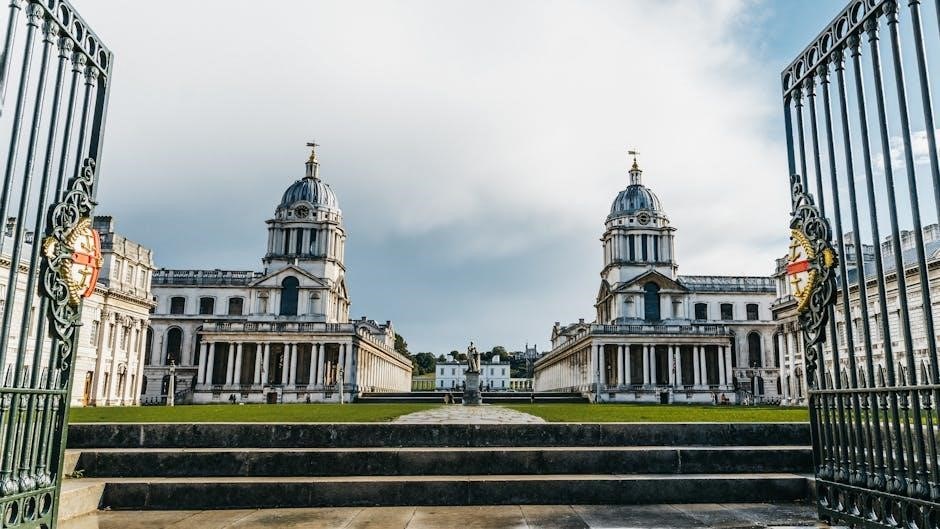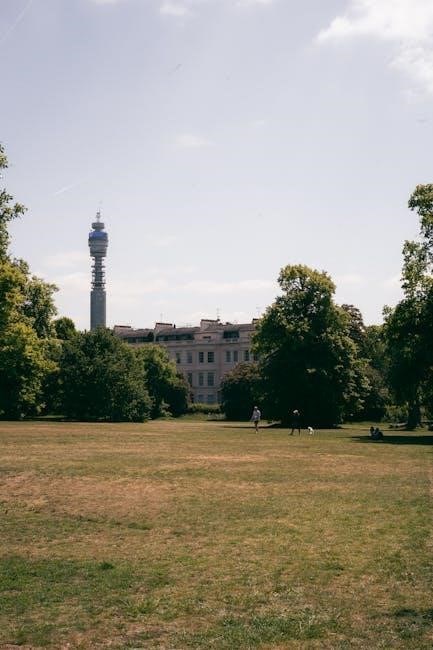
William Blake, a visionary poet and artist, stands as a bridge between the 18th and 19th centuries, influencing Romanticism. His poem London, from Songs of Experience, critiques social injustices, showcasing his unique blend of spirituality and political activism. Blake’s work remains a cornerstone of literary analysis, offering profound insights into human suffering and societal corruption, making him a pivotal figure in literary studies.
1.1. William Blake: A Pre-Romanticist Poet and Artist
William Blake, often regarded as a pre-Romanticist, bridged the gap between 18th-century rationalism and the emotional intensity of Romanticism. A poet, artist, and visionary, Blake infused his work with spiritual and political themes, challenging societal norms. His illuminated texts, including London, showcased his unique artistic style and profound critique of urban life. Blake’s poetry, rich in symbolism, reflected his concern for humanity’s plight under industrialization and oppression. As a forerunner of Romanticism, he influenced later poets with his emphasis on imagination and individualism, leaving a lasting legacy in both literature and art. His work remains a cornerstone of literary and artistic analysis.
1.2. The Significance of “London” in Blake’s Works
London stands as a pivotal piece in William Blake’s oeuvre, encapsulating his deep concern for social justice and urban decay. Written in 1792 and published in Songs of Experience in 1794, the poem offers a scathing critique of 18th-century London’s societal ills. Through vivid imagery, Blake portrays the city’s corruption, exploitation, and human suffering, reflecting his broader themes of oppression and the loss of innocence. The poem’s concise yet powerful structure underscores Blake’s ability to convey profound political and moral messages, making London a cornerstone of his work and a seminal piece in literary analysis, highlighting his role as a social critic and visionary artist.

Historical Context of “London”
Written in 1792 and published in 1794, London reflects the city’s social and political turmoil during the Industrial Revolution, critiquing inequality and injustice amidst urbanization.
2.2. The Social and Political Climate of 18th-Century London
In 18th-century London, social inequality and political oppression were rampant. The city, a hub of industrialization, witnessed exploitation of the poor, with child labor prevalent. Blake’s London critiques this era, highlighting the suffering of chimney sweeps and the oppression of the marginalized. The monarchy and Church were seen as complicit in perpetuating injustice. Urbanization and industrial growth exacerbated poverty, creating stark contrasts between wealth and deprivation. Blake’s portrayal of London as a place of despair and corruption reflects the broader social and political discontent of the time, offering a searing indictment of a system that perpetuated human misery and moral decay.
Line-by-Line Analysis of the Poem
A line-by-line analysis of London reveals Blake’s meticulous critique of urban life. Each line underscores themes of oppression and despair, reflecting 18th-century London’s social ills. The imagery, such as “charter’d streets” and “mind-forg’d manacles,” symbolizes systemic control and mental enslavement. The poem’s structure, with short, rhythmic lines, amplifies its emotional impact. Scholars like Norman Fairclough apply his 3D model to uncover power dynamics, while Marxist critics highlight class struggles. This methodical approach exposes the poem’s layered meanings, linking Blake’s vision to broader societal critiques, making it a rich text for analytical exploration and interdisciplinary study.
3.1. Stanza-by-Stanza Breakdown and Interpretation
The first stanza of London introduces the city’s oppressive atmosphere, with “charter’d streets” symbolizing restrictive order. The second stanza highlights exploitation, focusing on chimney sweepers’ suffering. The third stanza critiques militarism and nationalism, while the final stanza portrays the loss of innocence through the “youthful harlot.” Each stanza builds on themes of oppression, using vivid imagery like “mind-forg’d manacles” to illustrate mental and societal constraints. This structured breakdown reveals Blake’s layered critique of urban life, emphasizing systemic injustice and human despair. The poem’s concise, rhythmic lines amplify its emotional and ideological impact, making it a powerful commentary on 18th-century London’s social ills.
3.2. Imagery, Symbolism, and Themes in “London”
Blake’s London employs stark imagery to depict a city suffocated by oppression. Symbols like “charter’d streets” and “mind-forg’d manacles” highlight systemic control and mental enslavement. The “chimney-sweeper’s cry” symbolizes exploited innocence, while “blood of youth” signifies life drained by oppression. Themes of social injustice, exploitation, and urban decay dominate, with London portrayed as a place where hope is extinguished. Blake’s vivid imagery and symbolism underscore the dehumanizing effects of industrialization and societal corruption, creating a powerful critique of 18th-century London’s moral and political decay. These elements collectively paint a haunting vision of a city consumed by suffering and injustice.
Themes and Motifs in “London”
Blake’s London explores themes of oppression, exploitation, and social injustice. The poem vividly portrays human suffering, moral decay, and the city’s emotional and societal corruption.
4;1. Oppression, Exploitation, and Social Injustice
In London, Blake vividly portrays a city plagued by oppression and exploitation. He highlights the plight of chimney sweeps, soldiers, and the poor, whose voices are silenced by systemic injustice. The “mind-forged manacles” symbolize the mental and emotional shackles imposed by societal structures. Blake’s imagery of “blood down palace walls” underscores the exploitation of the vulnerable by those in power. The poem serves as a scathing critique of 18th-century London’s social hierarchy, revealing the deep-rooted inequalities and human suffering that define the city’s moral decay. Blake’s work remains a powerful indictment of systemic oppression.
4.2. The Corruption of Innocence and the City’s Decay
Blake’s London mourns the loss of innocence amidst urban decay. The “youthful harlot’s curse” and “newborn infant’s tear” symbolize the corruption of innocence by societal ills; The city’s moral rot is mirrored in its physical decay, with “chartered streets” and “palace walls” stained by suffering. Blake critiques how institutional corruption seeps into every aspect of life, destroying purity and hope. The poem’s haunting imagery reflects the devastating impact of urbanization and moral neglect, painting a bleak picture of a city consumed by its own decay. This theme remains central to Blake’s vision of a society in spiritual and moral crisis.

Scholarly Approaches to Analyzing “London”
Scholars analyze London through New Historicism and Marxist Criticism, exploring power dynamics and social critique. These approaches reveal Blake’s condemnation of oppression and systemic injustice in society.
5.1. New Historicism and Social Criticism in the Poem
New Historicist scholars examine London as a critique of 18th-century societal norms, emphasizing Blake’s portrayal of urban oppression. The poem’s imagery, such as the “charter’d street” and “cry / Of every Man,” reflects systemic exploitation. By highlighting the suffering of marginalized groups—chimney sweeps, soldiers, and prostitutes—Blake critiques institutional power and its role in perpetuating inequality. This approach underscores how historical contexts, like the Industrial Revolution, shaped the poem’s themes of oppression and resistance. Blake’s work thus serves as a powerful indictment of social injustice, aligning with New Historicist focus on power dynamics and cultural critique.
5;2. Marxist Criticism: Power Dynamics and Hegemony

Marxist critics interpret London as a scathing critique of capitalism and class oppression. Blake depicts the exploitation of labor, particularly through the image of the “chimney-sweeper’s cry,” symbolizing the commodification of childhood innocence. The “mind-forg’d manacles” highlight how ideological control perpetuates systemic oppression, aligning with Marxist theories of hegemony. The poem critiques the bourgeoisie’s exploitation of the proletariat, with institutions like the Church complicit in maintaining power imbalances. Blake’s portrayal of urban decay and human suffering reflects the alienation inherent in capitalist systems. His work thus serves as a powerful indictment of economic and social exploitation, resonating with Marxist analyses of power and class struggle.

The Legacy of “London” in Modern Literature
William Blake’s “London” profoundly influenced Romantic and Victorian poetry, its themes of social injustice and urban decay remaining relevant in contemporary literature and societal critiques today.
6.1. Influence on Romantic and Victorian Poetry
William Blake’s London significantly influenced Romantic and Victorian poetry, inspiring poets like William Wordsworth and Samuel Taylor Coleridge. Its themes of urban decay and social injustice resonated deeply, shaping the Romantic movement’s focus on nature and humanity. Victorian poets, such as Charles Dickens and Thomas Carlyle, drew parallels with Blake’s critique of industrialization and exploitation. Blake’s mystical and political elements also inspired later writers to explore the interplay between spirituality and social reform. His vivid imagery and symbolism, as seen in London, became a blueprint for addressing societal ills, ensuring his work remains a cornerstone of literary influence across generations.
6.2. Contemporary Relevance of Blake’s Themes
William Blake’s themes in London remain strikingly relevant today, resonating with modern issues like urbanization, inequality, and systemic oppression. The poem’s depiction of exploitation and social decay aligns with contemporary concerns about labor rights, poverty, and environmental degradation. Blake’s critique of power structures and hegemony echoes in today’s discussions on systemic racism, gender inequality, and class disparities. His emphasis on the loss of innocence and spiritual decay mirrors modern anxieties about technological alienation and moral erosion. As a result, London continues to inspire activists and scholars, offering a timeless lens through which to examine societal ills and advocate for change.
William Blake’s London remains a powerful critique of societal oppression, its themes of exploitation and decay resonating deeply. Blake’s visionary art continues to inspire modern literary and social critique, offering timeless reflections on humanity’s struggles.
7.1. Synthesizing the Analysis: Blake’s Vision of London
William Blake’s London presents a haunting vision of a city plagued by social injustice and human suffering. Through vivid imagery and symbolism, Blake critiques the exploitation of the working class, the corruption of innocence, and the oppressive systems that perpetuate inequality. His portrayal of the city as a place of despair and moral decay reflects his deep concern for humanity’s spiritual and physical well-being. By exploring themes such as poverty, exploitation, and resistance, Blake’s poem offers a powerful commentary on the darker aspects of urban life, blending his unique mystical insights with sharp social criticism.
7.2. The Enduring Impact of “London” on Literary Studies
William Blake’s London continues to resonate in literary studies for its profound critique of societal oppression and human suffering. Its exploration of themes such as exploitation, corruption, and resistance has influenced numerous scholars and writers. The poem’s vivid imagery and symbolic language provide a rich terrain for critical analysis, particularly through lenses like Marxism and New Historicism. Blake’s vision of a decaying city has inspired later poets and remains a pivotal text in understanding the Romantic and Victorian eras. Its contemporary relevance underscores the timeless nature of its themes, cementing its place as a foundational work in literary scholarship and social critique.